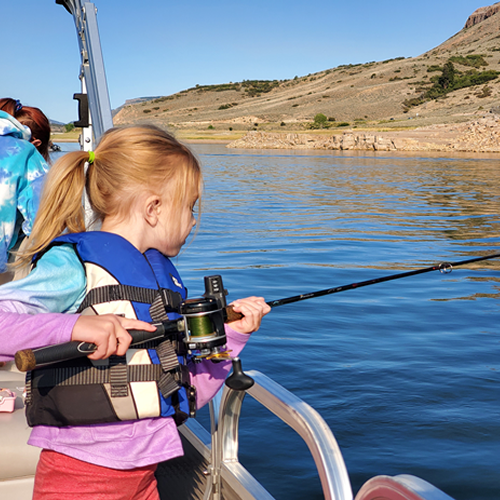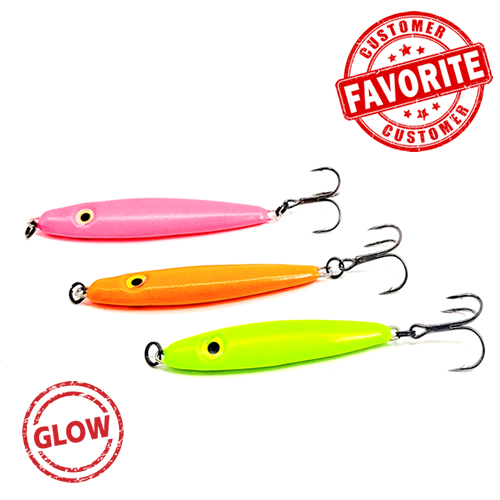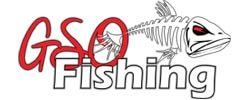
In the fall, during the pre-spawn and spawn, Kokanee will go off feed and begin their movements towards their spawning grounds. For us, this means they are no longer roaming the open water in search of plankton where they are readily caught trolling. Now, these fish are staged on the bottom of the lake or suspended in the water column in large schools, awaiting their time to spawn. Their activity level drops, and many of these fish are not willing to chase or strike a trolled lure. Jigging becomes the best way to catch these fish during this timeframe.
A vertical presentation with a jig keeps the lure right in front of a Kokanee’s view, eventually causing it to strike, but how do you know which jig to use?
Jig Color: What color should you start with, and when do you know to change colors? Much like lure selection while trolling, Kokanee can be very picky when it comes to a certain color of lure. The common colors for triggering Kokanee to bite are green, pink, or orange, but as is the case with trolling, jig color selection can be just as important. Keep a good selection of colors on hand to see which one gets them to trigger.
Jig Weight: There are many factors to consider when picking a jig weight. User preference, the angler’s skill level, drop rate, and if the school of Salmon are aggressive or skittish, just to name a few.
Some anglers prefer a certain jig weight no matter the conditions, and other anglers who may be new to jigging might find it easier to feel the jig when it’s heavier. As the angler jigs up and down, they need to be able to feel where the jig is and detect bites. We suggest starting with a heavier jig because it will be much easier to feel, compared to a lighter weight jig, when fishing in 60, 80, or over 100 feet of water.
Something else to consider is the drop rate of the jig and if the school you have stopped on is aggressive or skittish. A heavy jig that drops fast into a skittish school of Kokanee can cause them to run. A lighter jig will sink slower, and you can often get it into the school without them “running.”
On the flip side, if you have an aggressive group of salmon, a heavier jig will often have a faster reaction time when jigging and can cause the fish to react to your lure and strike.
Glow Or No Glow: Bright glowing jigs, especially ones that glow their true color, are usually the preferred choice when jigging for Kokanee. However, there are times when a dark or no-glow jig can and will catch more fish for you. We start with glow jigs and note if the fish seem skittish around them or often ‘run’ from the lures. If that is the case, we switch over to darker-colored jigs.
Charging Your Glow Jigs: Because glow-in-the-dark baits use absorbed light to emit a color, the light will “go out” after time and need re-charged.
The easiest way to recharge glow jigs is by placing them in direct sunlight for a few minutes. If your jigs are in a clear tackle box, you can just set the entire box in the sunlight and let them charge as you fish.
If there is no sunlight to charge your glow lures, you can buy a UV Flashlight to charge them. This process can take a bit longer and cost you prime fishing time, but it definitely works.
Another option is that several companies make a “charging box,” which is a small tackle box filled with UV light to keep your glow baits charged.
Check Your Split Rings: A common mistake we see anglers make when jigging for Kokanee salmon is not checking the split rings on their jigs. Kokanee fight hard when hooked, and it can cause the split ring to bend or open. If you continue to fish with a bent split ring, it can lead to you losing the fish and sometimes even the lure.
Bringing a pair of split ring pliers and some spare split rings is important. Check your rings after every catch and whenever you are changing your bait/corn or scent.
If the ring is pulled open, use the pliers to close it again and if the ring is damaged, switch it out for a fresh one.
In the fall, with so many fish being concentrated and locked into one small area, a jig is a more efficient way to continue to catch fish rather than troll through, reset, and troll back through the area. With the right jig color and weight for the conditions, you can increase your chances of not only getting your lure in front of the Salmon but also getting them to react and strike your lure.

Click here to find the perfect jig color and weight for your next Kokanee Salmon jigging trip, from our selection of glow and nonglow Agitators.
What Are Kokanee Salmon???
Click here for more great information about what Kokanee Salmon are and what they look like.
Additional Blog Posts
For information about the corn and scent we use to tip our jig hooks, visit our blog post ‘Trolling With Corn – Kokanee Salmon.’ We use the same corn and scents for both trolling and jigging.
If you have any questions, click our chat button here on our website or email us at info@gsofishing.com. We are here to help. – Team GSO Fishing
